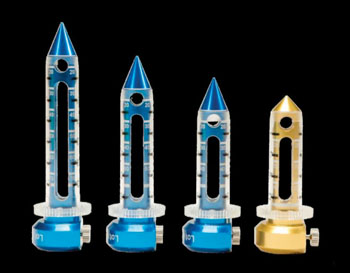Brain Access Sheath Safely Displace Subcortical Tissue
By HospiMedica International staff writers
Posted on 23 Sep 2014
A novel access device minimizes neural damage by gently displacing tissues during advancement towards hard-to-reach brain abnormalities.Posted on 23 Sep 2014
The BrainPath device provides surgical access to brain abnormalities in the subcortical space of the brain that may have once been considered inoperable. Placed through a small craniotomy, the BrainPath is advanced through the natural folds of the brain, using a parallel approach to the brain fiber tracts, thus reducing the potential for tissue damage that may cause deficits after surgery. The device consists of a reusable, resterilizable obturator and a disposable sheath. Once these two components are assembled they are held together by an interference (friction) fit.

Image: The NICO BrainPath surgical obturators and sheaths (Photo courtesy of NICO).
After the creation of an appropriate craniotomy and dural incision, the BrainPath assembly is inserted into tissue to desired location, using depth bands on obturator and sheath as a reference during placement. Once in place, the sheath is advanced into position and the obturator removed. The sheath remains in the brain to serve as a protective portal that maintains access to the surgical site during tissue removal or fluid evacuation. The BrainPath device is a product of NICO (Indianapolis, IN, USA), and has been approved by the US Food and Drug Administration (FDA).
“Almost every day, we are seeing our designated BrainPath Center hospitals from around the country getting media attention because of the results they are seeing with patients who have had surgery with BrainPath,” said Jim Pearson, president and CEO of NICO Corporation. “These patients are amazed and elated with their postoperative results, but more than anything, they are asking why this procedure is not the new standard of care in neurosurgery.”
Related Links:
NICO














